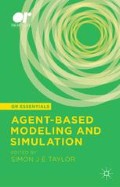Abstract
Agent-based modeling (ABM) has become a popular simulation analysis tool and has been used to examine systems from myriad domains. This article re-examines some of the scientific developments in computers, complexity, and systems thinking that helped lead to the emergence of ABM by shedding new light onto some old theories and connecting them to several key ABM principles of today. As it is often the case, examining history can lead to insightful views about the past, present, and the future. Thus, themes from cellular automata and complexity, cybernetics and chaos, and complex adaptive systems are examined and placed in historical context to better establish the application, capabilities, understanding, and future of ABM.
Access this chapter
Tax calculation will be finalised at checkout
Purchases are for personal use only
Preview
Unable to display preview. Download preview PDF.
References
Ashby WR (1956). An Introduction to Cybernetics. John Wiley and Sons, Inc: New York.
Axelrod R and Cohen MD (2000). Harnessing Complexity: Organizational Implications of a Scientific Frontier. Basic Books: New York.
Bankes SC (2002). Agent-based modeling: A revolution? In: Proceedings of the National Academy of Sciences of the United States of America. Vol. 99 (Supplement 3); Arthur M. Sackler Colloquium of the National Academy of Sciences, The National Academy of Sciences: Washington, DC, USA, pp 7199–7200.
Casti JL (1995). Complexification: Explaining a Paradoxical World Through the Science of Surprise. 1st edn, Harper Perennial, of Harper Collins: New York, NY.
Epstein JM and Axtell R (1996). Growing Artificial Socieities: Social Science from the bottom up. Brookings Institution Press: Washington, DC.
Ferber J (1999). Multi-agent Systems: An Introduction to Distributed Artificial Intelligence. Addison-Wesley: Harlow, England.
Gleick J (1987). Chaos: Making a New Science. Viking: New York, NY.
Holland JH (1995). Hidden Order: How Adaptation Builds Complexity. Helix Books: Cambridge, MA.
Ilachinski A (2000). Irreducible semi-autonomous adaptive combat (ISAAC): An artificial-life approach to land warfare. Mil Opns Res 5(3): 29–47.
Langton CG (1989). Artificial life. In: Langton CG (ed). Artificial Life. Addson-Wesley Publishing Company, Inc.: Redwood City, CA, pp 1–48.
Levy S (1992). Artificial Life: A Report from the Frontier where Computers Meet Biology. Vintage Books: New York, NY.
Macal CM and North MJ (2006). Tutorial on agent-based modeling and simulation part 2: How to model with agents. In: Perrone LF, Wieland FP, Liu J, Lawson BG, Nicol DM and RM Fujimoto (eds). Proceedings of the 2006 Winter Simulation Conference, Winter Simulation Conference: Monterey, CA, pp 73–83.
Mandelbrot BB (1982). The Fractal Geometry of Nature. W.H. Freeman: USA.
Mitchell M, Crutch J and Hraber P (1994). Dynamics, computation, and the ‘edge of chaos’: A re-examination. In: Cowan G, Pines D and Melzner D (eds). Complexity: Metaphors, Models and Reality. Vol. 19, Addison-Wesley: Reading, MA.
Neumann J von (1966). Theory of Self reproducing Automata In: Burks AW (ed). University of Illinois Press: Urbana and London.
Schelling TC (2006). Micromotives and Macrobehavior. 2nd edn, WW Norton and Company: New York.
Simon HA (1962). The architecture of complexity. In: Proceedings of the American Philosophical Society. Vol. 106, American Philosophical Society, pp 467–482.
Wiener N (1962). Cybernetics, or Control and Communication in the Animal and the Machine. 2nd edn, The MIT Press: Cambridge, MA.
Wolfram S (1994). Cellular Automata and Complexity: Collected Papers. Westview Press: USA.
Author information
Authors and Affiliations
Editor information
Editors and Affiliations
Copyright information
© 2014 Operational Research Society
About this chapter
Cite this chapter
Heath, B.L., Hill, R.R. (2014). Some insights into the emergence of agent-based modeling. In: Taylor, S.J.E. (eds) Agent-Based Modeling and Simulation. The OR Essentials series. Palgrave Macmillan, London. https://doi.org/10.1057/9781137453648_3
Download citation
DOI: https://doi.org/10.1057/9781137453648_3
Publisher Name: Palgrave Macmillan, London
Print ISBN: 978-1-349-49773-7
Online ISBN: 978-1-137-45364-8
eBook Packages: Palgrave Business & Management CollectionBusiness and Management (R0)

